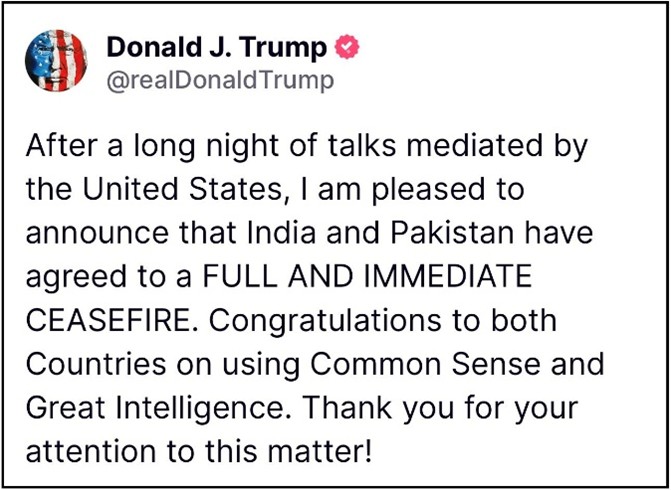May 14, 2025
On 22 April 2025, terrorists attacked Pahalgam-one of the most popular tourist destinations in Kashmir-killing twenty-six people. With a population of 13 million, the Indian-administered Kashmir hosts 700,000 troops, including army personnel, paramilitary forces, and police with extraordinary powers, making it one of the most militarized regions in the world.
Yet, despite the large number of tourists in Pahalgam, no security officer was on site. Rescue operations took hours to arrive. Today, even ordinary citizens can install basic security cameras cheaply. Why, then, was this high-profile area left unwatched-despite its long history of insurgency, terrorist attacks, and territorial disputes involving Pakistan, China, and India?
This is the hallmark of India's deep dysfunction-something one can grasp only by living in the country and being steeped in its social fabric. Reportedly, there were intelligence warnings ahead of the attack, and Modi had even cancelled a planned visit. But no one thought to warn the tourists. They were left as sitting ducks.
Never in my life have I seen evidence that Indians value human life. This disregard is embedded in their institutions, shaped by the feedback they receive, and reflected in the type of individuals who rise to power. For politicians, bureaucrats, and the armed forces, ordinary people are treated as little more than expendable guinea pigs.
Regardless of the circumstances, the priority remains: maximize bribe collection and secure electoral victories through demagoguery. The goal is to keep the population perpetually on edge-but not to the point of collapse-because a truly destabilized society would threaten their comfortable, insulated lifestyles.
In the aftermath of the Pahalgam attack, Satya Pal Malik, the former Governor of Kashmir, described Modi as shameless and a coward in a part-Hindi, part-English interview. But perhaps more damningly, drawing on his insider experience, he portrayed the regime as clueless and incompetent. Even during publicly presented as significant meetings, he said, little substance takes place-just good food and idle small talk.
Either way, the death of twenty-six people is a non-event in India. Even the deaths of hundreds often pass without a murmur. The police, driven purely by a predatory instinct, kill real or imagined criminals with impunity, including acting on behalf of mafia interests. The courts remain passive, and the public apathetic.
Indians and empathy have nothing in common.
In the absence of genuine leadership-and worse, under the rule of demagogues-hatred has been steadily intensifying across India. Linguistic, regional, and religious conflicts are on the rise. This was inevitable, especially as the country moved further away from British rule's relative sanity.
The rational, intelligent, and realistic Indians know that endemic corruption cannot be eradicated because the society lacks the moral impulse or consciousness to do so. Their best hope is for intelligent, even if corrupt, politicians to rise to power. However, in a society deeply fractured by caste, class, and tribal thinking, the ascent of capable leaders is another impossibility.
India's bored, TV-watching, so-called educated middle class suddenly latched onto the Pahalgam incident as a way to mask their anti-Muslim sentiments with a façade of empathy-and to feel vicariously brave. In the aftermath, Kashmiri and Muslim students were assaulted in various parts of the country. It's hard to fault Indians for being irrational-rationality simply doesn't feature in the equation.
Even with total media control, Modi couldn't stop the middle class from being whipped into a frenzy. The resulting surge of manufactured outrage ultimately led to desperate villagers being sent to the front lines. No one cares about their deaths. Isn't it remarkable how a mass of otherwise sheepish people can suddenly display such "courage" when swept up in mob fervor? See this.
With elections looming in the state of Bihar, Modi needed to play the strongman. But, like any demagogue, he had to ensure things didn't spiral out of control-stability, after all, is crucial for preserving his political position.
India launched mock military drills across the country, timed to coincide with what appeared to be its first planned strike on Pakistan. Yet, in typical Indian fashion, the execution was chaotic. I didn't come across a single place where the sirens worked, and people had no idea what to do. It was dysfunction as usual. See this.
In the early hours of 7 May 2025, over a hundred Indian fighter jets were mobilized in preparation for a dogfight. The aircraft remained on the Indian side of the border, firing from within Indian territory. Yet, according to Pakistani claims, within the first few hours, five Indian fighter jets crashed inside India-an estimated loss of nearly a billion dollars.
The Indian government offered no response. Prominent defence analyst Pravin Sawhney-whose book The Last War I recommend strongly-raised the issue in his two YouTube videos. The government promptly banned both, which, at least partially, confirms that the crashes likely occurred. (Readers in India are advised to use a VPN service to watch the following.) See here.
The well-known U.S.-based money manager Frank Holmes might have put it best: "Follow the money." The fighter jets used by Pakistan were manufactured by AVIC Chengdu Aircraft, whose share price surged significantly following the incident. In contrast, one of the Indian jets reportedly downed was a Rafale, which was four times more expensive than its Chinese counterpart, produced by Dassault Aviation. Dassault's share price dropped by around 10%.

If the Rafale was lost due to friendly fire or inadequate training-which seems likely, given that Pakistan, being similarly dysfunctional, was unlikely to have shot down five Indian planes within Indian territory while India was the aggressor-Dassault must be regretting the reputational damage India has inflicted upon it.
In fact, most fatalities in wars involving Third World countries result from friendly fire. These countries consistently struggle to operate the institutions originally established by European powers. See this.
Pakistan is no saint. It is merely the flip side of the same coin, with perhaps a layer of Islamic fervor. That said, it is hard to compare Tweedledee and Tweedledum, for when my mood is different, I think that Islam gives Pakistan at least some vague and hypocritical unity and honor.
When Indians look at Pakistan, they find it repulsive. Similarly, when Pakistanis look at India, they feel the same. Both fail to recognize that what they find repulsive in the other reflects their own image.
The Indian subcontinent is a region of thievery, scamming, and backstabbing. Your greatest enemies are your own family and neighbors. The India-Pakistan conflict is a macrocosm of this dysfunction. They cannot sit down to negotiate a lasting agreement, and, in truth, they don't really want peace. Vance had told the world that the US would not mediate, but they eventually did. For now, Trump's whip worked. Within hours, India and Pakistan agreed to a ceasefire. They had likely also run out of ammunition.

The Third World should rise to thank Pax Americana for its contributions over the past century. While it has had its many massive flaws, without it, the spineless tyrants of the Third World would have descended into complete savagery. Eventually, they will, and with much larger future populations-perhaps this is why the US should have stayed away. Moreover, the US has a thankless task: it will be blamed by both Pakistan and India for what they could have done to each other had the US not intervened.
No one knows which country truly dominated in the war. Both sides lied profusely, which obscured any truth that might have surfaced. South Asians don't understand the concept of speaking the truth. The Indian media claimed that the Indian army was all over Pakistan and that a full surrender was just days away. Regardless of what facts come to light in the future, citizens on both sides will continue to believe their side emerged victorious. They don't want to know the truth. They have no such interest.
People of the subcontinent want to believe in what is convenient, expedient, and portrays their tribe-whether India, Pakistan, Islam, Hinduism, or Sikhism-in a favorable light. The West utterly fails to understand this marked difference between their and Third World societies.
Citizens of India and Pakistan fail to realize that they will pay higher taxes and face greater internal security measures and tyranny. Ultimately, the demagogues of both countries seek just enough tension to keep their citizens distracted from the real issues: extreme poverty, stagnant or declining economies, increasing civil unrest, and the collapse of institutions.
There are only three winners in this mess. First is Narendra Modi, who is now guaranteed to sweep the October elections in Bihar. This war has elevated him to the status of a nationalist hero, ensuring India's further slide into both economic decline and, even worse, cultural regression. Second, the Pakistani army, which has bled Pakistan dry for decades. In the recent past, they had lost their legitimacy. The war with India has restored it, allowing them to continue their exploitation of the nation with impunity and their oppression in Balochistan, tightening their grip on a crumbling state. Third, AVIC Chengdu Aircraft, China's aerospace giant, is reaping profits as the world purchases more jets and missiles.
None of the citizens of these wretched, godforsaken countries will realize that their true enemy is not the other side, but their own governments and security forces. Despite being Islamic and supposedly non-idolatrous, Pakistan has, in the past, deified its army-or, more recently, figures like Imran Khan. Now, they are returning to worshiping their army once again. The Indian subcontinent will continue to simmer with hatred, destruction, a lack of trust, growing tyranny, emergency laws, heightened border tensions, and increased hostility towards minorities, gradually but inexorably pushing them toward their chaotic pre-British past.
